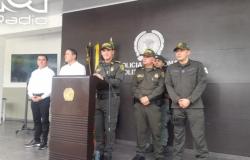Can you imagine being able to know how polarization on social networks, hate movements, segregation and violence begin and develop? The polarizometer may have the answer to understanding and addressing this phenomenon. The story begins a couple of years ago and ends in Valle del Cauca. But let’s go in parts…
The origin of this research project dates back to 2016, when some of the most notorious scandals occurred, nationally and internationally, related to social networks and their influence on recent democratic processes. Among them, we can mention the plebiscite that resulted in the separation of Great Britain from the European Union (better known as Brexit); the elections in the United States, which gave Donald Trump the winner, and the Cambridge Analytica company scandal.
At the local level, the Plebiscite for Peace, called by the government of then-president Juan Manuel Santos within the framework of peace negotiations with the FARC-EP, and, more recently, the use of social networks during the “outbreak “social” of 2021 in Cali, one of the epicenters of the demonstrations. They all had in common the use of social networks and the polarization generated among the population, regardless of the topic to be discussed.
“All these kinds of social events led us to ask ourselves what we could do to measure and predict polarization”, recalls Frank D. Valencia, CNRS researcher at the LIX École Polytechnique, associate professor at the Pontificia Universidad Javeriana (Cali Campus) and director of the project. He also points out that, although the phenomenon of polarization has always existed in societies, the use of social media has exacerbated it in an unprecedented way.
Uniting knowledge disciplines to understand a complex phenomenon
Due to the nature of the topic, the project raised the need for interdisciplinary work from the beginning. “Polarization does not occur in our field (of computing), but it occurs in real life. Psychologists, sociologists, political scientists and other disciplines also study it. It is natural that we work with other disciplines”explains Juan Francisco Díaz Frías, professor at the School of Systems and Computing Engineering and one of the project leaders.
With this in mind, we sought to integrate other disciplines of knowledge. Thus, in addition to professors and researchers from the Department of Electronics and Computer Science, professors and researchers from Political Sciences and Economics from the Javeriana University of Cali entered. Together with professors and researchers from the School of Systems and Computing Engineering of the Universidad del Valle and the LIX École Polytechnique, they integrated their knowledge to put it at the service of the community, especially in Valle del Cauca.
The project was called “Computational Models of Social Networks Applied to Polarization in Valle del Cauca”, but it is better known by its acronym PROMUEVA: Polarization in Social Networks with a Unified Model for El Valle.
It began in 2022, after winning a call from the General Royalties System, with the purpose of developing reliable computational models of social networks for the analysis of polarization. In this way, three objectives were set:
1. Develop a computational model of social networks to study polarization in them.
2. Develop mechanisms to specify and reason about privacy policies and leaks.
3. Develop efficient algorithms to analyze large-scale networks and machine learning algorithms to identify patterns or predict particular behaviors in relation to polarization in social networks.
As a head of the first objective, the School of Systems and Computing Engineering of the Universidad del Valle has used software to develop measurement models and subsequent applications, inviting students to be part of the research group and put their knowledge into practice in the subject.
“As our students have a good training, both in the development and in the fundamental concepts of computing, this has allowed them to contribute in several aspects. A web and mobile application is being developed that is, to some extent, scalable, and that is based on sound mathematical and engineering principles.says Jesús Alexander Aranda Bueno, professor and researcher at the School of Systems and Computing Engineering and one of the leaders of Objective 1 of the project.
The social network used as a basis for this project has been X (formerly known as Twitter), since it is the social network most used to express opinions. To study the behavior of citizens in terms of polarization, previous studies have been carried out, with information banks based on X, to test their measurement models. These models work based on known algorithms adapted by students, which use the principle of machine learning to classify the information obtained.
“They take the data, they process it, and they see how many of those who made comments seem to be completely in favor of health care reform, for example; how many seem to be in favor, although not completely; how many seem to be neutral; How many seem to be against it and how many are completely against it?explains Professor Juan Francisco Díaz.
He adds that, due to their working mechanism, these algorithms are programmed to learn to better classify the information obtained as they obtain more data. To do this, they use techniques called sentiment analysis and take into account the semantics of words. “There are already many generic tools that have been designed for this, and we are adapting them to our point and getting results”.
The result of this joint work between students and teachers from different areas is expected to result in two products, which will see the light and will be made available to the community of Valle del Cauca in the coming months: the “Polarizometer” and the Simulation Laboratory .
The Polarizometer and the Simulation Laboratory: bets to understand and predict polarization
The Polarizometer was born from the need to present advances in research to the young population, so that they could appropriate the concepts and feel attracted to using them. The idea was to take the models used out of abstraction and display them on a device that was familiar to them.
“At some point we came across the word ‘Polarizometer’, which was a device that measures polarization. How to measure temperature, just like a thermometer”explains Professor Juan Francisco Díaz.
The idea was initially tested manually, using Excel tables for the information and the formulas developed for its interpretation. Then it was thought that this same method should be implemented with a web application. Since then, it began to be developed so that the data (which can be generated online or offline) were then transformed into histograms, determining based on this the degree of polarization of the consulted population.
The mechanism to determine the level of polarization is similar to that used with the Gini measurement, which measures the levels of inequality in a society. The Polarizometer, in its first version, will be launched in August 2024 and is expected to become a fundamental tool for actors in society capable of making decisions that affect large groups, such as people immersed in politics. The option of presenting this tool in the Cali Council has even been raised, so that it can be known, for example, which discussions are leading to a greater degree of polarization.
For its part, the Simulation Laboratory seeks to know (and predict) how a society’s opinion regarding a topic may evolve. Knowing what people currently think, we seek to configure the simulator so that other scenarios can be analyzed, which could affect said opinions.
“Suppose that in this network (X) people remain silent (do not publish any tweets) when such a thing happens”, “suppose that in this network (X) people express their beliefs in this way”, are some of the examples offered by Professor Juan Francisco Díaz. Through said Laboratory it is expected to analyze in which cases there could be consensus on certain issues.
“That is more to experiment, from a scientific perspective, what can happen in networks, how they can be manipulated or how they can intervene so that certain scenarios occur”explains Díaz. He adds that, unlike the “Polarizometer,” the Simulator is designed to be used more by academic or research groups.
Dialogues with Artificial Intelligence
Although there is concern in the group about the rise of the different Artificial Intelligences that are being developed in the world, and how difficult it has become to discern whether one is communicating with a machine or with a person, this project has sought to use these advances technology in your favor.
“Artificial intelligence is present in our project. LLMs (large language models) are being used in the project. In particular, we are using the ChatGPT API in order to do sentiment analysis and post ranking. In this way, AI has become an ally”concludes Professor Jesús Alexander Aranda.
The project proposes, from now on, to continue searching for phenomena in Valle del Cauca, to put into practice the different developments made over these two years. Its results, with the Polarizometer and the Simulation Laboratory at the helm, promise to offer the community tools that allow them to be better informed when making decisions, which will undoubtedly result in a community aware of the importance of its opinions.
If you are interested in contacting the researchers or learning more about the project, write to the Communications Office of the Faculty of Engineering: [email protected]






